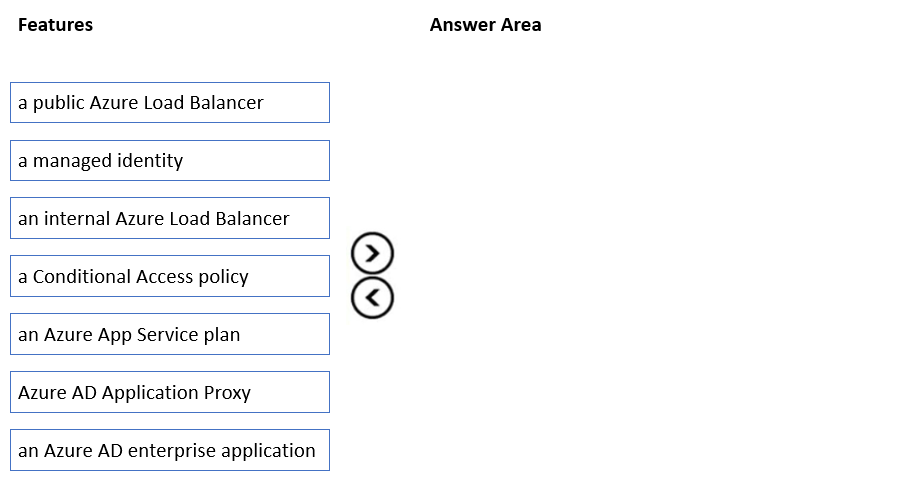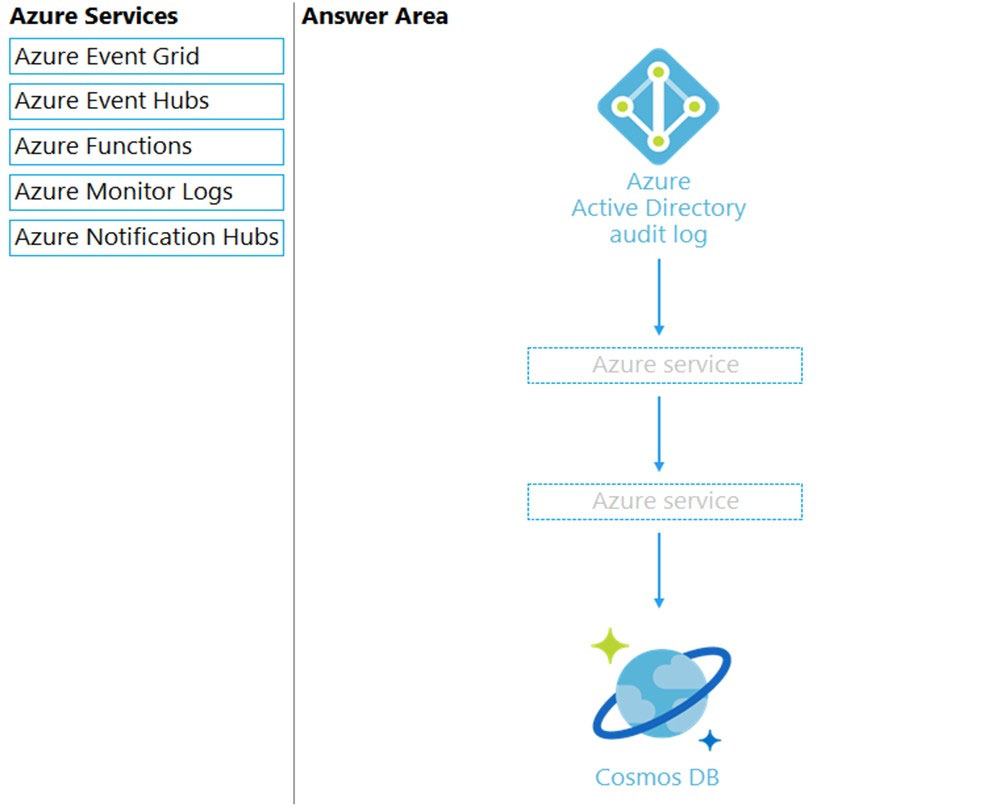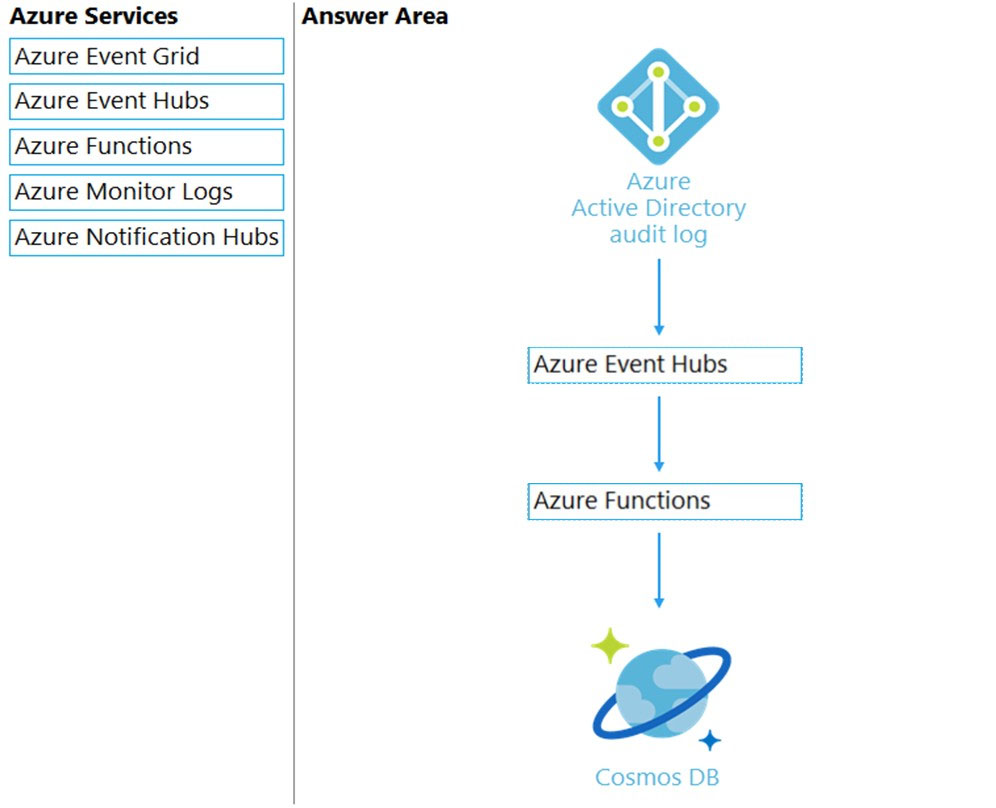You have an Azure subscription.
You need to recommend a solution to provide developers with the ability to provision Azure virtual machines. The solution must meet the following requirements:
✑ Only allow the creation of the virtual machines in specific regions.
✑ Only allow the creation of specific sizes of virtual machines.
What should you include in the recommendation?
Answer:
B
Azure Policies allows you to specify allowed locations, and allowed VM SKUs.
Reference:
https://docs.microsoft.com/en-us/azure/governance/policy/tutorials/create-and-manage
You are developing a sales application that will contain several Azure cloud services and handle different components of a transaction. Different cloud services will process customer orders, billing, payment, inventory, and shipping.
You need to recommend a solution to enable the cloud services to asynchronously communicate transaction information by using XML messages.
What should you include in the recommendation?
Answer:
C
Asynchronous messaging options.
There are different types of messages and the entities that participate in a messaging infrastructure. Based on the requirements of each message type, Microsoft recommends Azure messaging services. The options include Azure Service Bus, Event Grid, and Event Hubs.
Azure Service Bus queues are well suited for transferring commands from producers to consumers.
Data is transferred between different applications and services using messages. A message is a container decorated with metadata, and contains data. The data can be any kind of information, including structured data encoded with the common formats such as the following ones: JSON, XML, Apache Avro, Plain Text.
Reference:
https://docs.microsoft.com/en-us/azure/architecture/guide/technology-choices/messaging https://docs.microsoft.com/en-us/azure/service-bus-messaging/service-bus-messaging-overview
You have 100 devices that write performance data to Azure Blob Storage.
You plan to store and analyze the performance data in an Azure SQL database.
You need to recommend a solution to continually copy the performance data to the Azure SQL database.
What should you include in the recommendation?
Answer:
A
You need to recommend a storage solution for the records of a mission critical application. The solution must provide a Service Level Agreement (SLA) for the latency of write operations and the throughput.
What should you include in the recommendation?
Answer:
D
Azure Cosmos DB is Microsoft's fast NoSQL database with open APIs for any scale. It offers turnkey global distribution across any number of Azure regions by transparently scaling and replicating your data wherever your users are. The service offers comprehensive 99.99% SLAs which covers the guarantees for throughput, consistency, availability and latency for the Azure Cosmos DB Database Accounts scoped to a single Azure region configured with any of the five
Consistency Levels or Database Accounts spanning multiple Azure regions, configured with any of the four relaxed Consistency Levels. Azure Cosmos DB allows configuring multiple Azure regions as writable endpoints for a Database Account. In this configuration, Azure Cosmos DB offers 99.999% SLA for both read and write availability.
Reference:
https://azure.microsoft.com/en-us/support/legal/sla/cosmos-db/v1_3/
You are planning a storage solution. The solution must meet the following requirements:
✑ Support at least 500 requests per second.
✑ Support a large image, video, and audio streams.
Which type of Azure Storage account should you provision?
Answer:
B
Use Azure Blobs if you want your application to support streaming and random access scenarios.
It's ideal for applications that require high transaction rates or consistent low-latency storage.
Incorrect:
Not A: Standard storage accounts has a default maximum request rate per storage account 20,000 requests per second1, but is not optimized for video and audio streams.
Not C: Page blobs is best suited for random reads and random writes.
Not D: FileStorage storage accounts (premium) has a maximum concurrent request rate of 100,000 IOPS.
Maximum file size is 4 TB, but is not optimized for video and audio streams.
Reference:
https://docs.microsoft.com/en-us/azure/storage/common/storage-introduction https://docs.microsoft.com/en-us/azure/storage/files/storage-files-scale-targets
You are designing a large Azure environment that will contain many subscriptions.
You plan to use Azure Policy as part of a governance solution.
To which three scopes can you assign Azure Policy definitions? Each correct answer presents a complete solution.
NOTE: Each correct selection is worth one point.
Answer:
CEF
Azure Policy evaluates resources in Azure by comparing the properties of those resources to business rules. Once your business rules have been formed, the policy definition or initiative is assigned to any scope of resources that Azure supports, such as management groups, subscriptions, resource groups, or individual resources.
Reference:
https://docs.microsoft.com/en-us/azure/governance/policy/overview
DRAG DROP -
Your on-premises network contains a server named Server1 that runs an ASP.NET application named App1.
You have a hybrid deployment of Azure Active Directory (Azure AD).
You need to recommend a solution to ensure that users sign in by using their Azure AD account and Azure Multi-Factor Authentication (MFA) when they connect to App1 from the internet.
Which three features should you recommend be deployed and configured in sequence? To answer, move the appropriate features from the list of features to the answer area and arrange them in the correct order.
Select and Place:
Answer:

Step 1: Azure AD Application Proxy
Start by enabling communication to Azure data centers to prepare your environment for Azure AD Application Proxy.
Step 2: an Azure AD enterprise application
Add an on-premises app to Azure AD.
Now that you've prepared your environment and installed a connector, you're ready to add on-premises applications to Azure AD.
1. Sign in as an administrator in the Azure portal.
2. In the left navigation panel, select Azure Active Directory.
3. Select Enterprise applications, and then select New application.
4. Etc.
Reference:
https://docs.microsoft.com/en-us/azure/active-directory/app-proxy/application-proxy-add-on-premises-application
You need to recommend a solution to generate a monthly report of all the new Azure Resource Manager (ARM) resource deployments in your Azure subscription.
What should you include in the recommendation?
Answer:
A
Activity logs are kept for 90 days. You can query for any range of dates, as long as the starting date isn't more than 90 days in the past.
Through activity logs, you can determine:
✑ what operations were taken on the resources in your subscription
✑ who started the operation
✑ when the operation occurred
✑ the status of the operation
✑ the values of other properties that might help you research the operation
Reference:
https://docs.microsoft.com/en-us/azure/azure-resource-manager/management/view-activity-logs
Note: This question is part of a series of questions that present the same scenario. Each question in the series contains a unique solution that might meet the stated goals. Some question sets might have more than one correct solution, while others might not have a correct solution.
After you answer a question in this section, you will NOT be able to return to it. As a result, these questions will not appear in the review screen.
Your company deploys several virtual machines on-premises and to Azure. ExpressRoute is deployed and configured for on-premises to Azure connectivity.
Several virtual machines exhibit network connectivity issues.
You need to analyze the network traffic to identify whether packets are being allowed or denied to the virtual machines.
Solution: Install and configure the Azure Monitoring agent and the Dependency Agent on all the virtual machines. Use VM insights in Azure Monitor to analyze the network traffic.
Does this meet the goal?
Answer:
B
Use the Azure Monitor agent if you need to:
Collect guest logs and metrics from any machine in Azure, in other clouds, or on-premises.
Use the Dependency agent if you need to:
Use the Map feature VM insights or the Service Map solution.
Note: Instead use Azure Network Watcher IP Flow Verify allows you to detect traffic filtering issues at a VM level.
IP flow verify checks if a packet is allowed or denied to or from a virtual machine. The information consists of direction, protocol, local IP, remote IP, local port, and remote port. If the packet is denied by a security group, the name of the rule that denied the packet is returned. While any source or destination IP can be chosen,
IP flow verify helps administrators quickly diagnose connectivity issues from or to the internet and from or to the on-premises environment.
Reference:
https://docs.microsoft.com/en-us/azure/network-watcher/network-watcher-ip-flow-verify-overview https://docs.microsoft.com/en-us/azure/azure-monitor/agents/agents-overview#dependency-agent
DRAG DROP -
You need to design an architecture to capture the creation of users and the assignment of roles. The captured data must be stored in Azure Cosmos DB.
Which services should you include in the design? To answer, drag the appropriate services to the correct targets. Each service may be used once, more than once, or not at all. You may need to drag the split bar between panes or scroll to view content.
NOTE: Each correct selection is worth one point.
Select and Place:
Answer:

Box 1: Azure Event Hubs -
You can route Azure Active Directory (Azure AD) activity logs to several endpoints for long term retention and data insights.
The Event Hub is used for streaming.
Box 2: Azure Function -
Use an Azure Function along with a cosmos DB change feed, and store the data in Cosmos DB.
Reference:
https://docs.microsoft.com/en-us/azure/active-directory/reports-monitoring/concept-activity-logs-azure-monitor